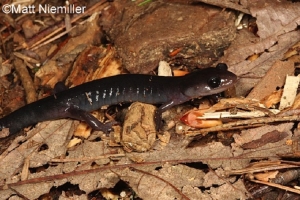Northern Gray-cheeked Salamander
Restricted to higher elevations of extreme northeastern Tennessee, Northern Gray-cheeked Salamander, Plethodon montanus, is a newly described species, which is part of the Jordan’s Salamanders complex along with Red-legged (P. shermani) and Red-cheeked Salamander (P. jordani). These closely related salamanders often hybridize. A long (3.5 to 5.0 inches in length) slate gray to bluish-black salamander with no distinguishing colors or markings. The belly is gray to black.
Similar Species: Red-cheeked Salamander, as its name suggests, has reddish cheek patches. Southern Appalachian Salamander has tiny white spots on the back and larger white spots on the sides.
Habitat: Found under moss, rocks, logs, and bark in cool, moist forests above 2500 feet; especially spruce-fir forests.
Diet: A variety of invertebrates, including spiders, moths, flies, beetles, bees, and snails.
Breeding information: Very little data. Adults breed on land, and eggs are assumed to be laid in underground cavities, similar to other Plethodon species. Females probably brood the eggs and hatchlings will emerge as miniature adults, as opposed to entering the larval stage.
Status in Tennessee: Habitat is less at risk from timber harvesting and farming; a major portion of their population occurs in the Great Smoky Mountain National Park or other protected land.
Fun Facts:
- Salamanders in Jordan’s Salamander complex are among the largest members of the genus Plethodon.
Best places to see in Tennessee: Higher elevation spruce-fir forests of the Great Smoky Mountains National Park.

